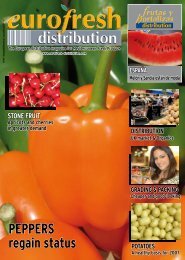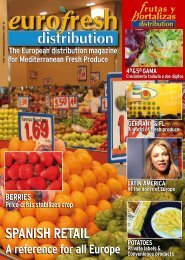produce - Eurofresh Distribution
produce - Eurofresh Distribution
produce - Eurofresh Distribution
You also want an ePaper? Increase the reach of your titles
YUMPU automatically turns print PDFs into web optimized ePapers that Google loves.
98<br />
OCTOBER<br />
NOVEMBER<br />
2 0 0 8<br />
uNited StateS<br />
argeNtiNa<br />
EUROFRESH<br />
DISTRIBUTION arouNd the world<br />
lemoN<br />
The world lemon crop is estimated at 8 million tonnes (excluding<br />
limes). The world trade in lemons is around 1. million tonnes. The<br />
major growing countries are Argentina, Spain and Turkey, for lemons.<br />
Mexico, Brazil and Peru are the main lime growers. China and<br />
India also grow lemons and limes.<br />
In California, a maturing technique called<br />
‘curing’ gives a top-of-the-range lemon that<br />
is synonymous with greater value added.<br />
The method consists in storing the lemons<br />
at a temperature of between 12.8 and 1 .<br />
ºC with to 8 % relative humidity. This<br />
improves the lemons’ resistance to transportinduced<br />
deterioration. This ‘curing’ gives the<br />
lemons a smoother, thinner skin and a more<br />
uniform colour.<br />
mexico aNd Brazil<br />
There are two major limegrowing<br />
countries: Mexico<br />
grows 1.9 million tonnes and<br />
Brazil 1 million. These two<br />
countries supply the world<br />
market, which is growing.<br />
Indeed, their exports have<br />
practically doubled in ten<br />
years. The Unites States is<br />
the top importing market in<br />
the world and Mexico is its<br />
main supplier. The secondlargest<br />
market is Europe, with<br />
80% Brazilian lime imports.<br />
At 1. million tonnes, Argentina is the<br />
top world grower of yellow lemons.<br />
Traditionally geared to processing,<br />
the Argentine lemon sector has also<br />
been exporting fresh fruit to Northern<br />
Hemisphere markets for some years<br />
now. The lemon growing area is in the<br />
north-west of the country, mainly in<br />
the province of Tucuman. The crop<br />
is made up of four main varieties:<br />
Eureka, Limoneira, Lisbon and Genova.<br />
Harvesting is spread out from May to<br />
September. Exports start from March<br />
onwards.<br />
italy<br />
SPaiN<br />
A crop estimated at slightly over 1 million tonnes<br />
places Spain as the second-ranking yellow lemon<br />
growing country in the world. The orchards are<br />
concentrated in the province of Murcia and the<br />
south of Alicante province. The Fino or Primofiori<br />
variety constitutes 0% of the orchards. Spain is the<br />
top world exporter but is suffering from an overproduction<br />
crisis at the moment. The fresh market<br />
is in recession in Western Europe and Argentine<br />
competition is making itself felt. The Spanish lemon<br />
sector also encounters competition from Turkey on<br />
the Eastern European markets.<br />
In Italy, the lemon orchards cover<br />
a little over 0,000 hectares. They<br />
are located essentially in Sicily. The<br />
varieties grown are Feminello and<br />
Monachello. With a crop of slightly<br />
more than 00,000 tonnes, Italy is not<br />
in the top ranks of exporting countries.<br />
It would seem that the profile of the<br />
orchards (small production units) and<br />
the production costs being too high<br />
are penalizing this sector. The Italian<br />
lemon sector is more geared to niche<br />
strategies (organic, etc.).<br />
iSrael<br />
The Israeli lemon crop<br />
is no more than 0,000<br />
tonnes. Almost 90% are<br />
sold for local consumption.<br />
With Villafranca as<br />
its main lemon variety,<br />
Israel exports none or<br />
very little. This variety<br />
seems to be less appreciated<br />
than others on the<br />
European market.<br />
euroPeaN uNioN<br />
The highest per capita lemon consumption, 2.9<br />
kg/year, is in the ‘old’ European Union (the EU-1 ).<br />
In the 12 new member states it is only 1.9 kg/year.<br />
In Russia the consumption per person is 1.<br />
kg/year, in the USA it is 1.2 kg/year and in Japan,<br />
0. kg/year. These figures give a better idea of<br />
why the main lemon exporters, Spain, Turkey and<br />
Argentina, are dependant on the EU market and its<br />
fluctuations.<br />
turkey<br />
Turkey is now the world’s thirdbiggest<br />
grower of yellow lemons<br />
( 00,000 to 800,000 tonnes). It is<br />
also one of the main movers on the<br />
world market. 0% of the orchards<br />
are in the south-east of the country,<br />
in the Mersin area. The main variety<br />
is Kütdiken ( 0% of the crop).<br />
Interdonato is the early variety that<br />
makes up 2 % of the crop.




